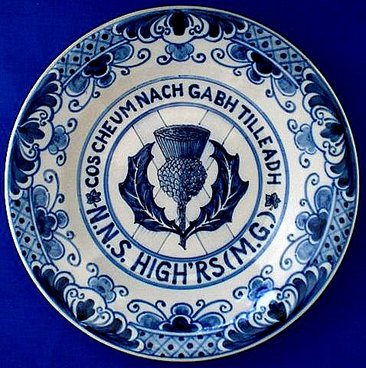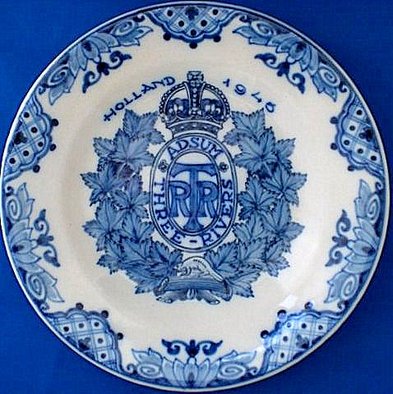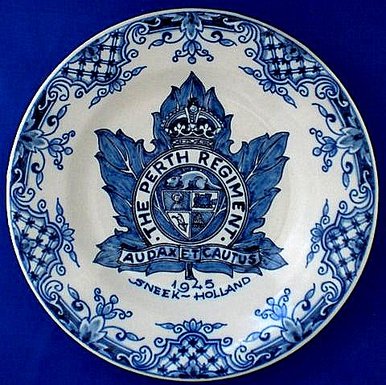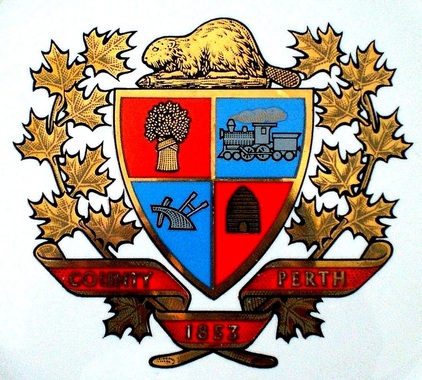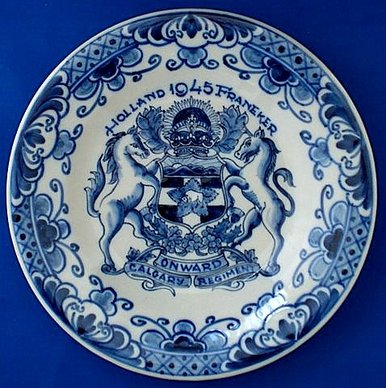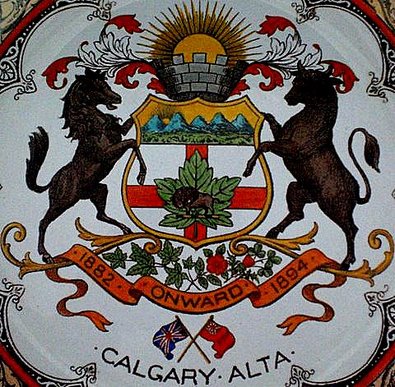Canadian Badges on Liberation Plates of the Netherlands
Auguste Vachon, Outaouais Herald Emeritus
Originally published in Gonfanon (Newsletter of the Royal Heraldry Society of Canada), Summer 2013, p. 3-5.
Between September 1945 and October 1946, the company Tichelaar Makkum, Royal Tichelaar Makkum since 1960, produced 12 blue and white Delftware plates dedicated to 11 regiments that liberated the Nertherlands, and one titled “O' Canada Thanks a Lot.” Via the Internet, my wife Paula Gornescu-Vachon was able to acquire nine of the twelve plates from a Dutch vendor, namely: The Three Rivers Regiment, The Prince Edward Island Light Horse, The North Nova Scotia Highlanders (M.G.), The Irish Regiment of Canada, The Cape Breton Highlanders, The Perth Regiment, The Calgary Regiment, The Princess Louise Fusiliers, and the Canadian Provost Corps. Three other pieces belong to the same series, namely: the Ontario Regiment, the Royal Canadian Electrical and Mechanical Engineers, and the “O' Canada Thanks a Lot” plate. The complete series is on display in the foyer of the town hall of Sneek where Canadian troops arrived on 13 April 1945. The town also erected a monument and a rotunda with a maple leaf dedicated to The Perth Regiment, which was stationed there after the cessation of hostilities.
The badges were drawn from the actual cap badges of the regiments. The flowery patterns, which are typical of the traditional Tichelaar Makkum production, are the work of Jan Steensma, a contemporary designer. The artists who hand painted the plates are identified underneath by their initials: Pieter Rinia (P.B.), Bouwe van der Molen (B), Tiemen Meinsma (Tm), and Jetze Kuipers (K).
The production was limited to 1140 plates, which divided by 12 would mean a limited edition of 95 each. However, because the pieces were made on order for members of the Canadian regiments remaining in the north after the liberation, the production was inevitably greater for some than for others. Some plates were brought to Canada while others were given to host families and stayed in the Netherlands. The series is not well known, no doubt because of its rarity. Very few of these plates have come up for sale on the Internet and almost always as a single unit.
Makkum, which was liberated on 19 April 1945, is a quaint fishing village of Friesland on the Zuiderzee (IJsselmeer), now largely reclaimed for agriculture. It also features canals, a dike, a marina filled with sailboats, and picturesque tiles incorporated into the town architecture. A pictorial record, where the factory is clearly identified, proves that Tichelaar Makkum has been in existence since 1572, which makes it well over 400 years old. It was acquired in 1676 by the Tichelaar family, whose name means brickmaker in old Dutch, and indeed the factory produced bricks for its first 100 years, until 1699 when Freerk Jans Tichelaar added tin-glazed tiles and household dishes to the production. The factory also produced ornamental pieces in which it eventually specialized as the market for everyday dishes became increasingly dominated by English wares.
The Tichelaars have lived for centuries in the centre of Makkum where their family home was built in 1669. The company is alive and well today and receives thousands of visitors each year. I am greatly indebted to Pieter Jan Tichelaar, director from 1965 to 1985 and historian of the company, whose works appear on the site: http://www.friesaardewerk.nl/ (consulted August 5, 2013). He provided me with all the precise information on the commemorative plates such as dates of production, quantity, painters involved, as well as the age of the Tichelaar Makkum factory. He also kindly proofread my manuscript for accuracy and has made useful suggestions. Further details were obtained from: Stephen J. Van Hook, Discovering Dutch Delftware: Modern Delft and Makkum Pottery (Glen Park Press: Alexandria [Virginia], 1998), p. 39-52.
The series commemorates some of the many events that brought Canada and the Netherlands together during and after the war. Knowledge of the plates' history is important for collectors and museologists who will eventually encounter examples of these rare artefacts in their collections. This article also brings home the fact that assumed arms, though sometimes naïve in design, are historical documents and part of Canadian history. We can improve on our heraldic past, but as heraldic historians, we cannot ignore it.
****
The illustrations below are all from the Auguste Vachon and Paula Gornescu-Vachon Collection of Heraldic China acquired by the Canadian Museum of Civilization in 2011, and designated as being “of outstanding significance and national importance” by the Cultural Property Export Review Board.
Between September 1945 and October 1946, the company Tichelaar Makkum, Royal Tichelaar Makkum since 1960, produced 12 blue and white Delftware plates dedicated to 11 regiments that liberated the Nertherlands, and one titled “O' Canada Thanks a Lot.” Via the Internet, my wife Paula Gornescu-Vachon was able to acquire nine of the twelve plates from a Dutch vendor, namely: The Three Rivers Regiment, The Prince Edward Island Light Horse, The North Nova Scotia Highlanders (M.G.), The Irish Regiment of Canada, The Cape Breton Highlanders, The Perth Regiment, The Calgary Regiment, The Princess Louise Fusiliers, and the Canadian Provost Corps. Three other pieces belong to the same series, namely: the Ontario Regiment, the Royal Canadian Electrical and Mechanical Engineers, and the “O' Canada Thanks a Lot” plate. The complete series is on display in the foyer of the town hall of Sneek where Canadian troops arrived on 13 April 1945. The town also erected a monument and a rotunda with a maple leaf dedicated to The Perth Regiment, which was stationed there after the cessation of hostilities.
The badges were drawn from the actual cap badges of the regiments. The flowery patterns, which are typical of the traditional Tichelaar Makkum production, are the work of Jan Steensma, a contemporary designer. The artists who hand painted the plates are identified underneath by their initials: Pieter Rinia (P.B.), Bouwe van der Molen (B), Tiemen Meinsma (Tm), and Jetze Kuipers (K).
The production was limited to 1140 plates, which divided by 12 would mean a limited edition of 95 each. However, because the pieces were made on order for members of the Canadian regiments remaining in the north after the liberation, the production was inevitably greater for some than for others. Some plates were brought to Canada while others were given to host families and stayed in the Netherlands. The series is not well known, no doubt because of its rarity. Very few of these plates have come up for sale on the Internet and almost always as a single unit.
Makkum, which was liberated on 19 April 1945, is a quaint fishing village of Friesland on the Zuiderzee (IJsselmeer), now largely reclaimed for agriculture. It also features canals, a dike, a marina filled with sailboats, and picturesque tiles incorporated into the town architecture. A pictorial record, where the factory is clearly identified, proves that Tichelaar Makkum has been in existence since 1572, which makes it well over 400 years old. It was acquired in 1676 by the Tichelaar family, whose name means brickmaker in old Dutch, and indeed the factory produced bricks for its first 100 years, until 1699 when Freerk Jans Tichelaar added tin-glazed tiles and household dishes to the production. The factory also produced ornamental pieces in which it eventually specialized as the market for everyday dishes became increasingly dominated by English wares.
The Tichelaars have lived for centuries in the centre of Makkum where their family home was built in 1669. The company is alive and well today and receives thousands of visitors each year. I am greatly indebted to Pieter Jan Tichelaar, director from 1965 to 1985 and historian of the company, whose works appear on the site: http://www.friesaardewerk.nl/ (consulted August 5, 2013). He provided me with all the precise information on the commemorative plates such as dates of production, quantity, painters involved, as well as the age of the Tichelaar Makkum factory. He also kindly proofread my manuscript for accuracy and has made useful suggestions. Further details were obtained from: Stephen J. Van Hook, Discovering Dutch Delftware: Modern Delft and Makkum Pottery (Glen Park Press: Alexandria [Virginia], 1998), p. 39-52.
The series commemorates some of the many events that brought Canada and the Netherlands together during and after the war. Knowledge of the plates' history is important for collectors and museologists who will eventually encounter examples of these rare artefacts in their collections. This article also brings home the fact that assumed arms, though sometimes naïve in design, are historical documents and part of Canadian history. We can improve on our heraldic past, but as heraldic historians, we cannot ignore it.
****
The illustrations below are all from the Auguste Vachon and Paula Gornescu-Vachon Collection of Heraldic China acquired by the Canadian Museum of Civilization in 2011, and designated as being “of outstanding significance and national importance” by the Cultural Property Export Review Board.
Badge of The Prince Edward Island Light Horse featuring the old arms of the province granted in 1905 with a lion added in the upper portion. Inscribed on reverse Tm in blue below the Tichelaar Makkum mark.
|
Badge of The North Nova Scotia Highlanders (M.G.). M.G. stands for machine gun. The Gaelic motto Cos Cheum Nach Gabh Tilleadh translates “Our footsteps will not allow us to go backwards” or more simply: “No retreat.” Inscribed on reverse Tm in blue below the Tichelaar Makkum mark.
|
Badge of The Three Rivers Regiment featuring its monogram, the beaver on a log, and a wreath of maple leaves. Adsum means “I am present.” Inscribed on reverse P.B. in blue below the Tichelaar Makkum mark.
Badge of The Perth Regiment displaying the assumed arms of Perth County. Audax et Cautus means “Bold and Wary.” Canadian troops entered Sneek on 13 April 1945. Inscribed on reverse P.B. in blue below the Tichelaar Makkum mark.
|
The assumed arms of Perth County from a Canadian Art China plate, 1960s to 1980s.
|

